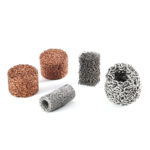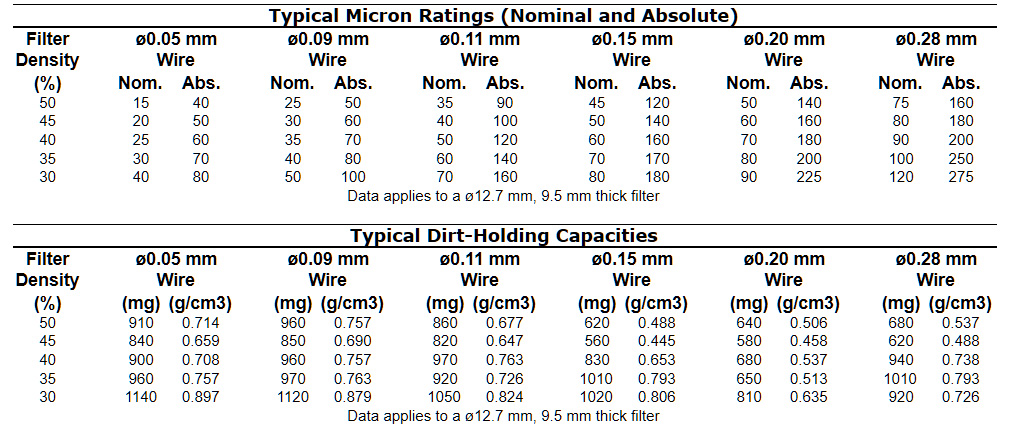Air & Liquid Filters
Superior Filtration in Hostile Environments with Knitted Wire Mesh
 Filtering liquids or air in hostile environments—such as those subject to temperature extremes, high orders of shock/vibration, and caustic fuels or fumes—has posed problems for paper filter elements. These types of elements simply will not withstand these types of operating conditions.
Filtering liquids or air in hostile environments—such as those subject to temperature extremes, high orders of shock/vibration, and caustic fuels or fumes—has posed problems for paper filter elements. These types of elements simply will not withstand these types of operating conditions.
Since paper filters are typically composed of organic materials, they are also subject to attack by the caustic byproducts of many industrial processes— such as those involving combustion. For example, corrosion often takes place when high-temperature lubricating oils are loaded with such acids. After extended use, the surface area of the paper filter becomes heavily loaded, resulting in filter weak spots. (If the pressure relief valve is not set low enough, and the pressure is allowed to remain at normal operating pressure [500 to 700 kPa], paper filter elements may tear, fracture, or even burst.)
Sintered metal filters—due to their granular construction—are also prone to fracture or disintegration when subjected to the stresses of high temperature and shock. Unless the fusion process involved in their construction is 100% complete, small particles may begin to break away. As a result, when installed on either rotating or reciprocating machinery, little particles of filter material very frequently detach and migrate to block the very devices the filter was designed to protect.
Metal Textiles knitted wire mesh liquid and air filters overcome the limitations and deficiencies of these and many other filtration methods. Where resistance to degradation, corrosion, mechanical, or thermal shock is desired—and where a resilient product is needed for proper cavity fit—Metal Textiles filters provide an economical, robust alternative. From cryogenic operating conditions up to temperatures of 650° C, knitted wire mesh filters maintain their integrity even when subjected to extremely high vibration and exposed to destructive gases such H2, SO4, and HNO3.
Metal Textiles Knitted Mesh—A Superior Alternative to Paper or Sintered Metal
 Knitted mesh consists of wires of various metals or strands of other materials that have been knitted into a mesh structure—creating a matrix of interlocking loops that can move freely in the same plane without distorting the mesh. (Each loop is actually free to move in three directions, and the finished metal knit permits two-way stretch.)
Knitted mesh consists of wires of various metals or strands of other materials that have been knitted into a mesh structure—creating a matrix of interlocking loops that can move freely in the same plane without distorting the mesh. (Each loop is actually free to move in three directions, and the finished metal knit permits two-way stretch.)
In addition, each loop acts as a small spring when subjected to compressive stress. Thus, filters of compressed knitted metal mesh yield when subject to the stresses of shock and vibration—yet, depending on the construction, can immediately recover to 90% of their original size when the force is removed.
Versatility for demanding filtration applications
Knitted mesh is also versatile. It can be made from any metallic, nonmetallic, or combination of metallic and nonmetallic materials that can be drawn into wire. By careful selection of the combination of materials, proper filtration can be provided in corrosive atmospheres, ultra-high and cryogenic temperatures, as well as for radioactively-contaminated dust particles, oil, or other extreme operating conditions.
Use of knitted mesh produces a “depth” or “three-dimensional” filter that provides an ideal tortuous-path-entrainment filtration effect. This is achieved by carefully balancing such variables as:
- Wire diameter
- Strand count
- Density and thickness of the pressed unit
- Configuration
Metal Textiles knitted wire mesh filters are used in the following applications:
- Engine crankcase—breather elements
- Air conditioning systems—to filter compressor oil from air and to remove pollen from intake air
- Restaurant range hoods—as grease traps
- Heating and ventilating systems—to filter dust
- Intake filters—for air compressors
- Clean air rooms—as dust traps
- Engine air intake filters
- Industrial vacuum cleaner filters
- Air cleaning and smog suppressant equipment
- Washing machines—as lint trap
The tables below list the particle-retention and dirt-holding capacities of typical units. (It should be noted that dirt-holding capacity is an important consideration only in applications where the filter will not be cleaned regularly.)



Recent Comments